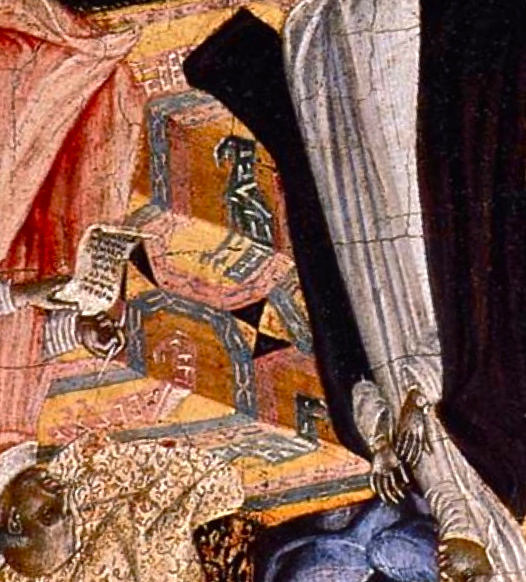 March 16th, 2011, 11:17 AM
March 16th, 2011, 11:17 AM
|
#9
|
|
Members
Join Date: Oct 2009
Posts: 153
|
 "well-fed animal" rug
"well-fed animal" rug
Hi Yohann,
Simone Martini‘ s painting (St. Louis of Toulouse crowning Robert of Anjou, Capodimonte, Naples) is indeed an interesting case: here the platform may be posed either on a rug, as suggested by R.E. Mack (1)) or on decorated tiles, but there is hardly any doubt that such rugs with parrots in an octagonal cartouche did exist.
Another example of this type of rug is shown in G. di Paolo’s painting «St Catherine before the Pope in Avignon» FIG a) and b).

 Fig a) and
Fig a) and
Fig b) Detail , rotated 180°
Giovanni di Paolo, St Catherine of Siena before the Pope Gregory XI in Avignon, 1460, Thyssen-Bornmisza. Madrid.(Date of painting questionable, but it was perhaps one of the many commissioned for the Saint’s canonization in 1461)
According again to Mack (2) «..the painter probably makes reference to the carpet with parrots... that chroniclers mention as constantly before the throne of Benedict XII in Avignon..to authenticate the setting of his painting...». Benedict, another Avignon Pope, was a notorious ruggie. Note that the parrot motif faces the enthroned Pope and not the visitors.
One can see a portion of a narrow and simple border.
I agree with you that painters must have (very often) introduced invented elements of decoration in their paintings, it is what we call «licence artistique»; Elements fully invented or closely inspired by objects in their possession or in possession of the people who ordered the painting (the latter being more likely in the case of the awfully expensive rugs of the Renaissance period).
(1). Rosamond E. Mack, Bazaar to Piazza, Islamic trade and italian art, 1300-1600, page 75.
(2). ibid. page 199, footnote #15
|

|

|